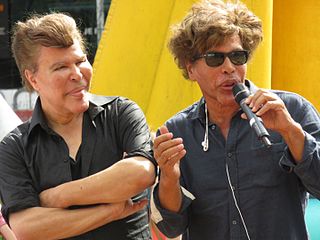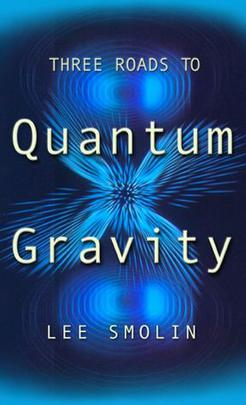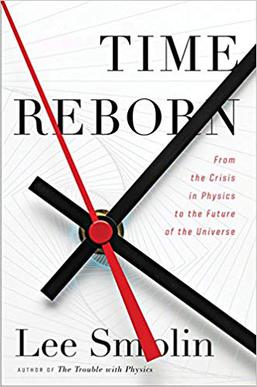
Quantum gravity (QG) is a field of theoretical physics that seeks to describe gravity according to the principles of quantum mechanics. It deals with environments in which neither gravitational nor quantum effects can be ignored, such as in the vicinity of black holes or similar compact astrophysical objects, such as neutron stars, as well as in the early stages of the universe moments after the Big Bang.
In physics, string theory is a theoretical framework in which the point-like particles of particle physics are replaced by one-dimensional objects called strings. String theory describes how these strings propagate through space and interact with each other. On distance scales larger than the string scale, a string looks just like an ordinary particle, with its mass, charge, and other properties determined by the vibrational state of the string. In string theory, one of the many vibrational states of the string corresponds to the graviton, a quantum mechanical particle that carries the gravitational force. Thus, string theory is a theory of quantum gravity.

Lee Smolin is an American theoretical physicist, a faculty member at the Perimeter Institute for Theoretical Physics, an adjunct professor of physics at the University of Waterloo, and a member of the graduate faculty of the philosophy department at the University of Toronto. Smolin's 2006 book The Trouble with Physics criticized string theory as a viable scientific theory. He has made contributions to quantum gravity theory, in particular the approach known as loop quantum gravity. He advocates that the two primary approaches to quantum gravity, loop quantum gravity and string theory, can be reconciled as different aspects of the same underlying theory. He also advocates an alternative view on space and time that he calls temporal naturalism. His research interests also include cosmology, elementary particle theory, the foundations of quantum mechanics, and theoretical biology.
Doubly special relativity (DSR) – also called deformed special relativity or, by some, extra-special relativity – is a modified theory of special relativity in which there is not only an observer-independent maximum velocity, but also an observer-independent maximum energy scale and/or a minimum length scale. This contrasts with other Lorentz-violating theories, such as the Standard-Model Extension, where Lorentz invariance is instead broken by the presence of a preferred frame. The main motivation for this theory is that the Planck energy should be the scale where as yet unknown quantum gravity effects become important and, due to invariance of physical laws, this scale should remain fixed in all inertial frames.

Leonard Susskind is an American theoretical physicist, Professor of theoretical physics at Stanford University and founding director of the Stanford Institute for Theoretical Physics. His research interests are string theory, quantum field theory, quantum statistical mechanics and quantum cosmology. He is a member of the US National Academy of Sciences, and the American Academy of Arts and Sciences, an associate member of the faculty of Canada's Perimeter Institute for Theoretical Physics, and a distinguished professor of the Korea Institute for Advanced Study.

Joseph Gerard Polchinski Jr. was an American theoretical physicist and string theorist.

The Bogdanov affair was an academic dispute regarding the legitimacy of obtaining Ph.D. degrees by French twins Igor and Grichka Bogdanov and a series of theoretical physics papers written by them in order to obtain degrees. The papers were published in reputable scientific journals, and were alleged by their authors to culminate in a theory for describing what occurred before and at the Big Bang.

The Road to Reality: A Complete Guide to the Laws of the Universe is a book on modern physics by the British mathematical physicist Roger Penrose, published in 2004. It covers the basics of the Standard Model of particle physics, discussing general relativity and quantum mechanics, and discusses the possible unification of these two theories.

Peter Woit is a senior lecturer in the Mathematics department at Columbia University. Woit, a critic of string theory, has published a book Not Even Wrong (2006) and writes a blog of the same name.
In string theory, the string theory landscape is the collection of possible false vacua, together comprising a collective "landscape" of choices of parameters governing compactifications.

Three Roads to Quantum Gravity: A New Understanding of Space, Time and the Universe is a non-fiction book by American theoretical physicist Lee Smolin. The book was initially published on May 30, 2001 by Basic Books as a part of the Science Masters series.
Cosmic Variance was a collaborative weblog discussing physics, astrophysics, and other topics, written by JoAnne Hewett, Mark Trodden, Sean Carroll, Risa Wechsler, Julianne Dalcanton, Clifford Johnson, John Conway, and Daniel Holz. It was the successor to Carroll's earlier blog Preposterous Universe, which began in early 2004 and ran through much of 2005. The blog's name came from the cosmology concept of cosmic variance.

Luboš Motl is a Czech physicist and blogger. He was an assistant professor in physics at Harvard University from 2004 to 2007. His scientific publications were focused on string theory. He was a visiting scholar at Rutgers in high energy physics.

"An Exceptionally Simple Theory of Everything" is a physics preprint proposing a basis for a unified field theory, often referred to as "E8 Theory", which attempts to describe all known fundamental interactions in physics and to stand as a possible theory of everything. The paper was posted to the physics arXiv by Antony Garrett Lisi on November 6, 2007, and was not submitted to a peer-reviewed scientific journal. The title is a pun on the algebra used, the Lie algebra of the largest "simple", "exceptional" Lie group, E8. The paper's goal is to describe how the combined structure and dynamics of all gravitational and Standard Model particle fields are part of the E8 Lie algebra.

Jan Zaanen was a Dutch professor of theoretical physics at Leiden University. He is best known for his contributions to the understanding of the quantum physics of the electrons in strongly correlated material, and in particular high temperature superconductivity. Zaanen's areas of interest were in the search for novel forms of collective quantum phenomena realized in systems built from mundane constituents like electrons, spins, and atoms.
In non-technical terms, M-theory presents an idea about the basic substance of the universe. Although a complete mathematical formulation of M-theory is not known, the general approach is the leading contender for a universal "Theory of Everything" that unifies gravity with other forces such as electromagnetism. M-theory aims to unify quantum mechanics with general relativity's gravitational force in a mathematically consistent way. In comparison, other theories such as loop quantum gravity are considered by physicists and researchers/students to be less elegant, because they posit gravity to be completely different from forces such as the electromagnetic force. As of 2024, there is no experimental evidence for M-theory.
Phenomenological quantum gravity is the research field that deals with the phenomenology of quantum gravity. The relevance of this research area derives from the fact that none of the candidate theories for quantum gravity has yielded experimentally testable predictions. Phenomenological models are designed to bridge this gap by allowing physicists to test for general properties that the hypothetical correct theory of quantum gravity has. Furthermore, due to this current lack of experiments, it is not known for sure that gravity is indeed quantum, and so evidence is required to determine whether this is the case. Phenomenological models are also necessary to assess the promise of future quantum gravity experiments.

Time Reborn: From the Crisis in Physics to the Future of the Universe is a 2013 book by the American theoretical physicist Lee Smolin.

Rainbow gravity is a theory that different wavelengths of light experience different gravity levels and are separated in the same way that a prism splits white light into the rainbow. This phenomenon would be imperceptible in areas of relatively low gravity, such as Earth, but would be significant in areas of extremely high gravity, such as a black hole. As such the theory claims to disprove that the universe has a beginning or Big Bang, as the big bang theory calls for all wavelengths of light to be impacted by gravity to the same extent. The theory was first proposed in 2003 by physicists Lee Smolin and João Magueijo, and claims to bridge the gap between general relativity and quantum mechanics. Scientists are currently attempting to detect rainbow gravity using the Large Hadron Collider.

Sabine Karin Doris Hossenfelder is a German theoretical physicist, philosopher of science, author, science communicator, YouTuber, musician, and singer. She is the author of Lost in Math: How Beauty Leads Physics Astray, which explores the concept of elegance in fundamental physics and cosmology, and of Existential Physics: A Scientist’s Guide to Life’s Biggest Questions.













